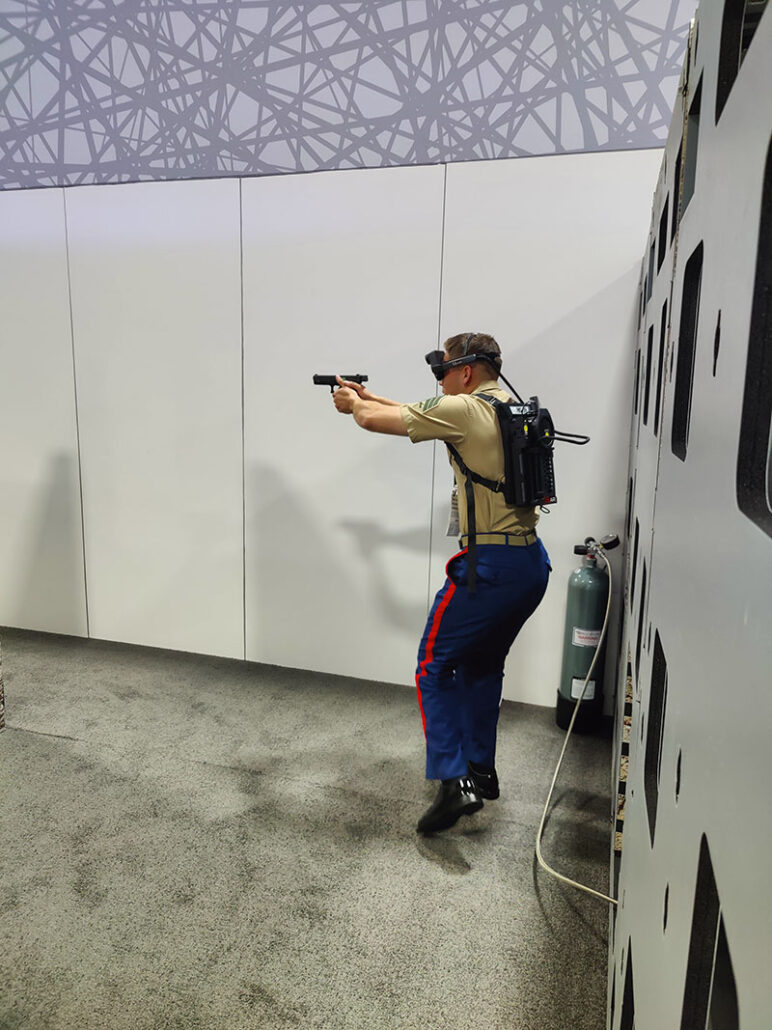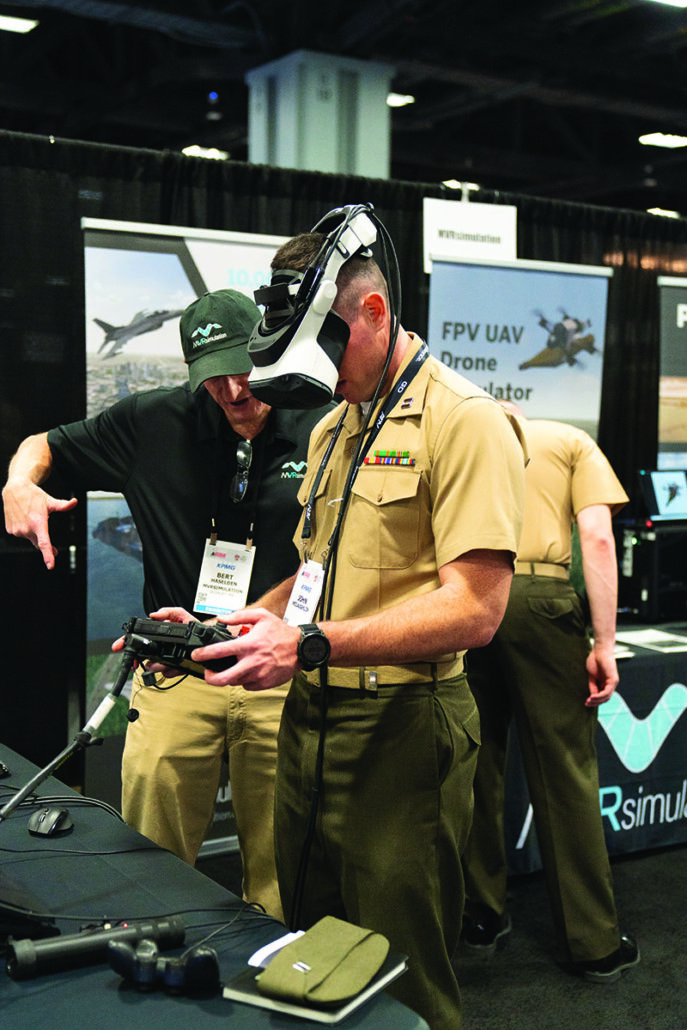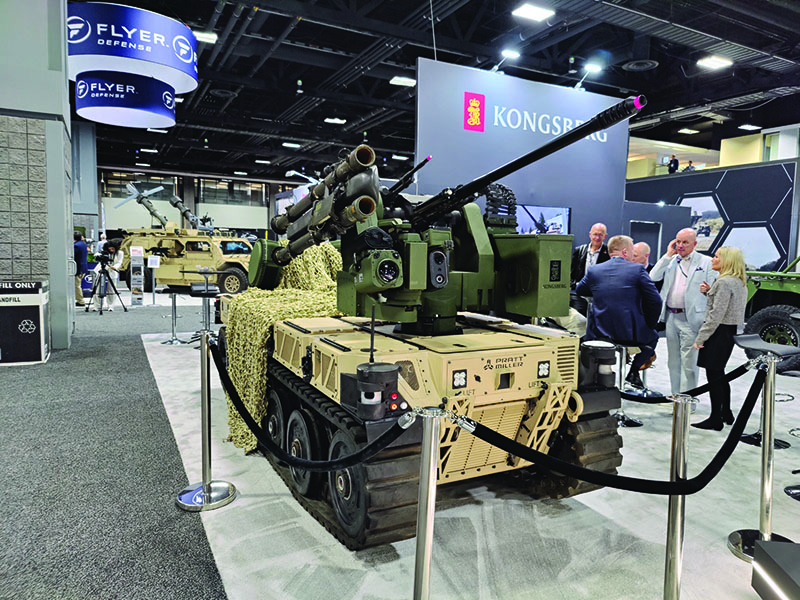
Modern Day Marine: The Future of Fighting Now
By: Sam LichtmanPosted on July 15, 2025
For Colonel Stuart W. Glenn, it’s an opportunity to test his skills in military strategy at the Commandant’s Cup Wargaming Tournament finals. For Lance Corporal Omariyon Wright, it’s a chance to “stay in the know… [about] all the modern-day technology, weapons, vehicles” and other equipment coming soon to the fleet. For Marines of all ranks, Modern Day Marine is a highlight of the year, providing the premier venue for learning about the state of the Corps and gaining an inside perspective on its areas of growth.
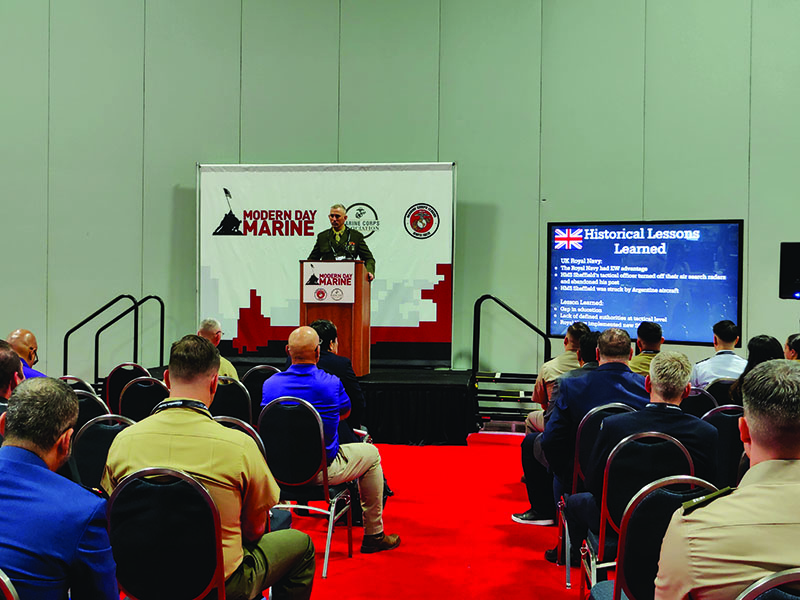
“The future of warfare is right now, so seeing what we have, current capabilities and what future developments we’re currently making is pretty cool,” said Sergeant Bryan Arteaga Celeiro, an air traffic control Marine who attended the 2025 expo, which is cohosted by the Marine Corps Association and the Marine Corps League.
Of special note at this year’s show was the preponderance of products aimed at training and education. From virtual reality (VR) and augmented reality (AR) headsets to recoil-simulating dummy rifles, Marines at the expo were given ample opportunity to try out high-tech training systems designed to help improve mission-critical skills in a variety of military occupational specialties. With the 39th Commandant’s Planning Guidance directing the Marine Corps to “fully integrate constructive and virtual training into [its] exercises… [to] train with the full complement of [its] new capabilities,” Leatherneck paid special attention to companies exhibiting training systems, including some that are already in service.
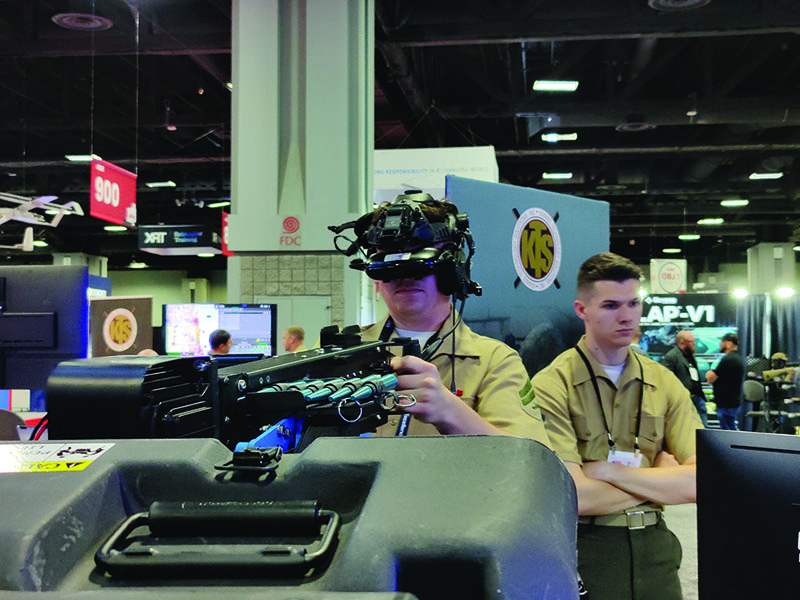
InVeris Training Solutions
Some of the crowd favorites at this year’s Modern Day Marine were the firearm training systems (FATS®) exhibited by InVeris Training Solutions. Throughout the expo, a near-constant stream of Marines and civilians passed through InVeris’ booth and fired off tens of thousands of simulated rounds at virtual targets and computer-generated hostiles.
Most Marines and soldiers are already familiar with the company’s FATS 100MIL as the Indoor Simulated Marksmanship Trainer (ISMT) and Engagement Skills Trainer (EST), respectively. It uses a projector and screen to create a virtual shooting range for up to five shooters (or up to 15 with three systems linked together) to practice with replica pistols, rifles, shotguns, grenade launchers and various crew-served weapons. Virtual ranges can be configured with a variety of static and moving targets and simulate the effects of environmental conditions on ballistics, applying the correct amount of drop and wind drift depending on distance.
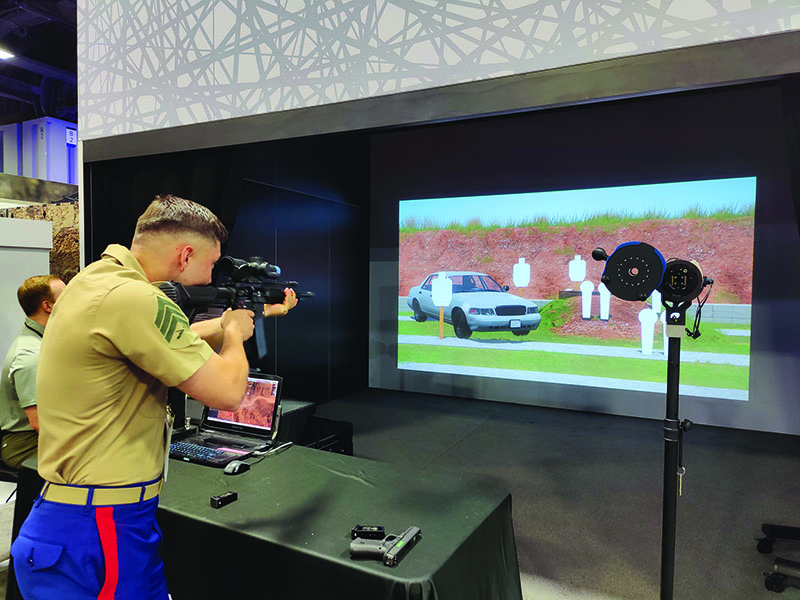
The FATS AR takes virtual firearms training into the third dimension, using a lightweight augmented reality (AR) headset to transform any indoor environment up to 10,000 square feet in size into a simulated shoot house for up to four users at once. Enemy combatants and civilians behave realistically, either using AI or a human operator monitoring the situation from outside. After clearing the shoot house, shooters can walk back through and watch a playback of themselves in real time to analyze their own performance.
Every “firearm” compatible with InVeris’ training simulators has nearly identical weight, balance and controls to the live-fire model from which it is rebuilt, and even simulates about 60 percent of a realistic recoil impulse using a gas blowback system feeding from a compressed air capsule in the magazine. The weapon can be programmed to hold a preset number of “rounds” per magazine and lock the bolt or slide back on empty, just like a real firearm. Magazines are recharged between sessions using a large scuba-type tank holding enough compressed air for about 45,000 shots, allowing shooters to practice all day for literal pennies on the dollar.
This isn’t just a high-tech version of an arcade game, though—a suite of onboard electronics wirelessly linked to a control computer offers highly sophisticated analytics to assist each shooter in correcting bad habits that would have otherwise gone unnoticed. After a shooting stage is completed, the software shows the operator how long it took for each shooter to begin firing, engage each target and transition between targets, with a line showing the point of aim throughout. Are you slapping the trigger, holding your firing hand too low on the grip or jerking the rifle under recoil? InVeris’ software can help your instructor show you exactly where you need to improve your shooting.
In addition to aiding basic marksman-ship practice without the need for a real range or live ammunition, InVeris’ virtual firearm trainers provide a safety benefit, as they allow novice shooters to practice handling their service weapons with no risk of negligent discharge. The safety benefits also extend to personnel in com-bat arms MOS’s; whereas firing a live mortar produces the type of concussive blasts that have been linked to traumatic brain injury, simulated shots are perfectly safe.
InVeris does not claim that their FATS can completely replace live-fire marksmanship training, but military and law enforcement organizations around the world have already recognized the value in these simulations. The U.S. Army and Marine Corps use the FATS 100MIL virtual range, as mentioned above; the Air Force and Coast Guard use the FATS AR, and the U.S. Marshals Service has evaluated it.
Ultimate Training Munitions
Virtual firearms training with sim-ulated recoil is certainly impressive technology, but for force-on-force training, a different solution is needed. As its name suggests, Ultimate Training Munitions (UTM) offers a line of nonlethal ammunition and conversion kits that allow existing firearms to use it.
Conceptually similar to Simunitions, UTM’s solution consists of drop-in re-placement bolt carrier groups for rifles, submachine guns and machine guns, and replacement slide assemblies for pistols. Special magazines which are identical in size to standard ones but are physically incapable of loading UTM ammunition and vice versa are also used. Even if a live round were to be force fed into a UTM weapon or the other way around, the primers are in different locations, preventing a potentially catastrophic accident.
The UTM bullet contains a spherical plunger which continues moving forward when the projectile impacts a target, spraying out a small amount of marking paint more reliably than paintball-type projectiles. A firearm training system is useless if it does not offer adequate accuracy, so the UTM bullet includes a driving band—like on an artillery shell—which allows the rifling in the host firearm’s barrel to stabilize the projectile just like an ordinary bullet. The company claims better than 2-inch groups at 27 yards with 5.56 rifles such as the M4 and M27, entirely adequate for close-quarters battle-type scenarios.
To enable force-on-force training with its marking ammunition, UTM also offers a variety of protective gear, such as face masks compatible with helmets and communications devices. Because the projectiles travel at a modest 300 to 375 feet per second, face protection and padding around sensitive body areas are the only specialized equipment needed to prevent serious injury to someone shot with UTM rounds. Because of the lack of penetrating power, a military unit or law enforcement agency using UTM equipment can use the aptly named Portable Training Facility system to quickly construct a shoot house using metal poles and tarpaulin-like walls and doors.
For realistic training outside force-on-force scenarios, UTM conversion kits also work with “battlefield blanks,” which create realistic noise and recoil without firing a projectile, and “silent blanks,” which still cycle UTM actions without creating any potentially dangerous muzzle blast.
Although a UTM-converted firearm is even less powerful than a paintball gun, its blowback action generates a realistic recoil impulse and cyclic rate of fire, enhancing training. Firing a converted HK MR556 (similar to the M27 IAR) inside UTM’s plexiglass enclosure at the expo was a highly immersive experience: the recoil, the action noise, the sound of spent casings bouncing off the floor and even the smell of burnt powder all mimicked the sensations associated with a live firearm and real ammunition. Al-though hearing protection was not required, the sound of the gunshots was similar to that of a real gunshot heard through hearing protection.
Due to its greater complexity to manufacture, UTM ammunition is more expensive than standard lethal ammunition, but like InVeris’ FATS, its purpose is not to replace live-fire marksmanship train-ing. Instead, UTM firearms and ammuni-tion allow military and law enforcement personnel to “train how they fight,” prac-ticing close combat as realistically as possible so as to maximize performance on the actual battlefield. Air Force Security Forces, Coast Guard, Army and SOCOM (including MARSOC) per-sonnel have already been training with UTM kits; the Marine Corps has a program of record for it as well, meaning UTM may soon become widespread in infantry units.
Cole Engineering Services’ Stinger Training System
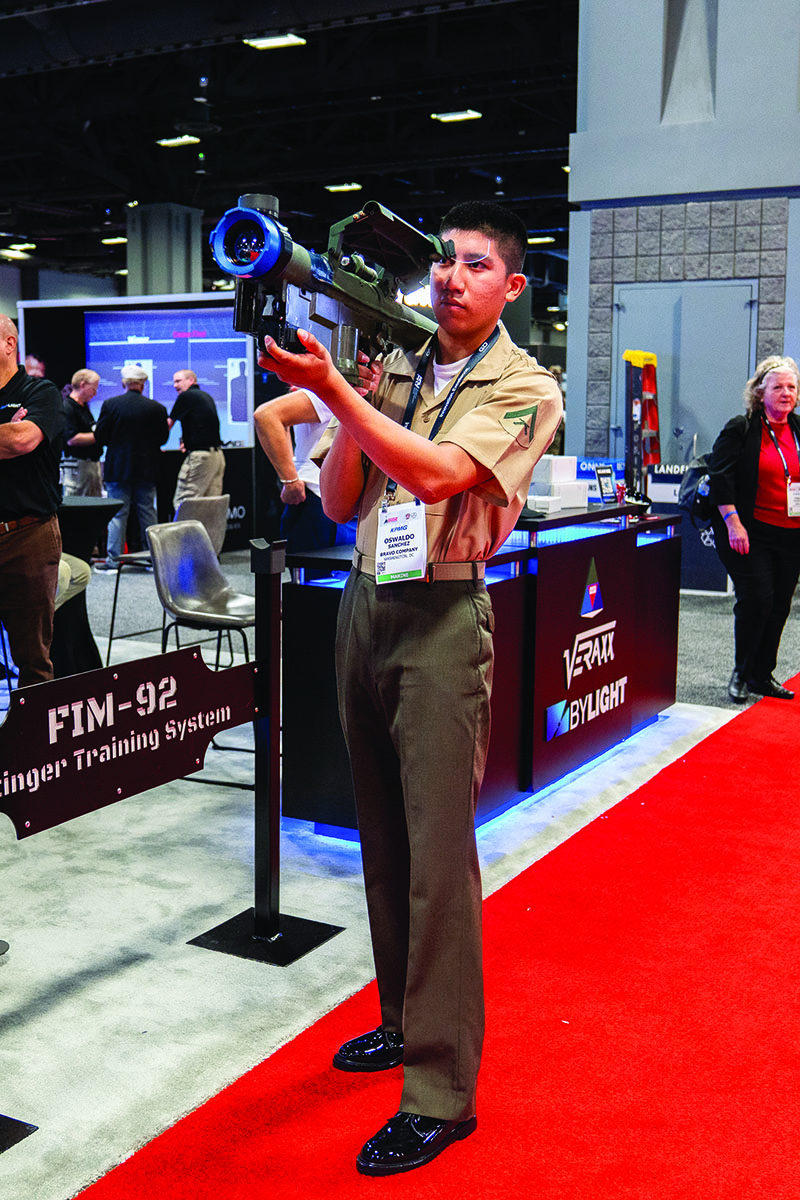
At its large booth along the show floor’s main thoroughfare, By Light Professional IT Services showed off its child companies’ vehicle and small arms trainers. Cole Engineering Services displayed its modular training systems for the FIM-92 Stinger surface-to-air missile and crew-served mortars, all built around an electronics package dubbed the “cyclops.” Cole’s Stinger training system consists of a dummy gripstock and launch tube, the former of which has a socket for the “cyclops.” Once the “cyclops” has established a wireless connection to a computer or smartphone, the user operates the launcher exactly as he or she would a live one, while the electronics log analytics in real time throughout the firing cycle. The entire system can be used by itself or connected to a computer network that automatically adjudicates “hits” and “misses” for force-on-force exercises, which is how the Army has utilized the Stinger trainer so far. For training with mortars and other heavy weapons, the “cyclops” can be swapped over to other dummy launchers, its onboard software automatically adjusting to the different behavior of each weapon.
The Army already uses Cole Engineering Services’ Stinger trainer, and the company is eager to obtain a Marine Corps contract. Due to the considerable cost of Stinger missiles and the disposable battery coolant units they consume, Low Altitude Air Defense (LAAD) gunners ordinarily have little opportunity for practice, potentially inhibiting combat effectiveness. Given the proliferation of small unmanned aerial systems (UAS) on the modern battlefield, an electronic training system such as this one could be more valuable than ever in remedying that training gap and ensuring LAAD gunners are already proficient before they ever fire live missiles.
MVRsimulation’s Deployable Joint Fires Trainer
The high-tech training systems on display at this year’s Modern Day Marine were by no means limited to small arms. MVRsimulation demonstrated its mixed-reality Deployable Joint Fires Trainer (DJFT), which the Air Force and III MEF already use to train joint terminal attack controllers (JTACs) and forward observ-ers (FOs). First fielded three years ago, the DJFT consists of three portable work-stations with peripherals designed to emulate the real equipment, such as radios and laser designators, that JTACs and FOs use. The physical hardware is visible inside the computer-generated environment projected in the virtual reality headset, allowing the user to interact with it seamlessly. This blending of the real and virtual worlds creates an almost uncanny level of immersion.
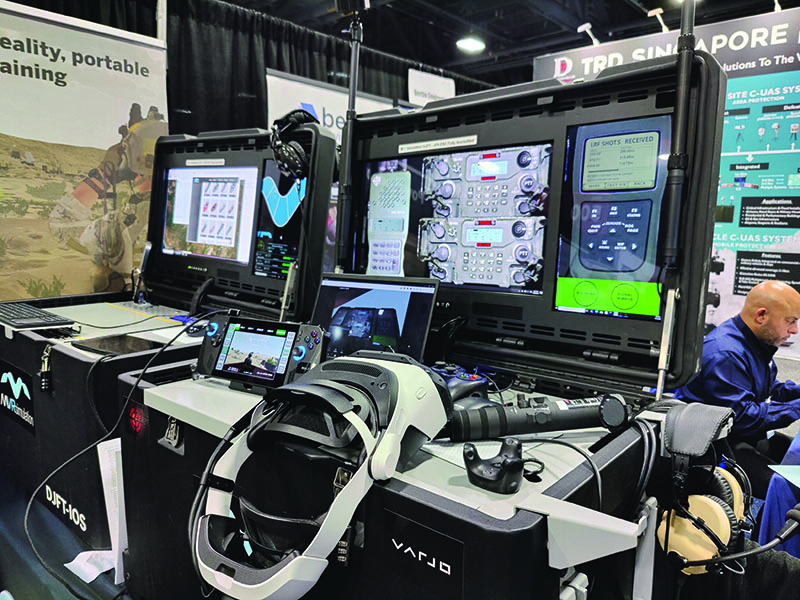
The three stations are configured for an observer, an instructor and a role player, the latter of whom uses a hands-on throttle-and-stick controller to fly aircraft in the simulation. All three users interact with each other through a virtual recreation of real-life locations, run on MVRsimulations’ Virtual Reality Scene Generator engine or the Modern Air Combat Environment produced by Battlespace Simulations. The computers inside each station are built with the same components one might find in a high-end professional workstation or gaming computer and run Windows 10, ensuring compatibility with other hardware and software. Each machine is light enough to be carried by two people in its packed state and has a unified onboard power supply, needing only one wall outlet for the entire station instead of one for each component inside.
Forterra’s AutoDrive and Allen Control Systems’ Bullfrog
The past few years have seen an explosion in unmanned ground vehicle (UGV) development. Companies such as Pratt Miller and Oshkosh Defense have developed small UGVs with adequate mobility to keep up with a Marine rifle squad as it moves over rough terrain, providing integrated logistics and fire support at the small unit level. All that capability comes at a cost, however. Every infantryman designated to control a UGV is a Marine not using his or her rifle, which could pose a problem in combat. Clearly, before UGVs are widely fielded in the Marine Corps, a solution is needed to eliminate the task of leading vehicles around like pack animals.
To that end, Forterra (formerly Robotic Research Autonomous Industries) spe-cializes in UGV autonomy. Their flagship product, AutoDrive®, is a retrofit package consisting of a 50-pound ruggedized computer “brain” connected to a sensor suite, capable of autonomously driving an otherwise manned or remotely con-trolled ground vehicle. The brain is more durable than a human driver, and all the sensitive electronics inside are shielded against electromagnetic interference to prevent disruptions to the mission. Although an AutoDrive-equipped vehicle can be controlled wirelessly by a remote operator anywhere in the world, its onboard software allows it to intelligently navigate to a designated location using the best available route while recognizing and avoiding environmental hazards.
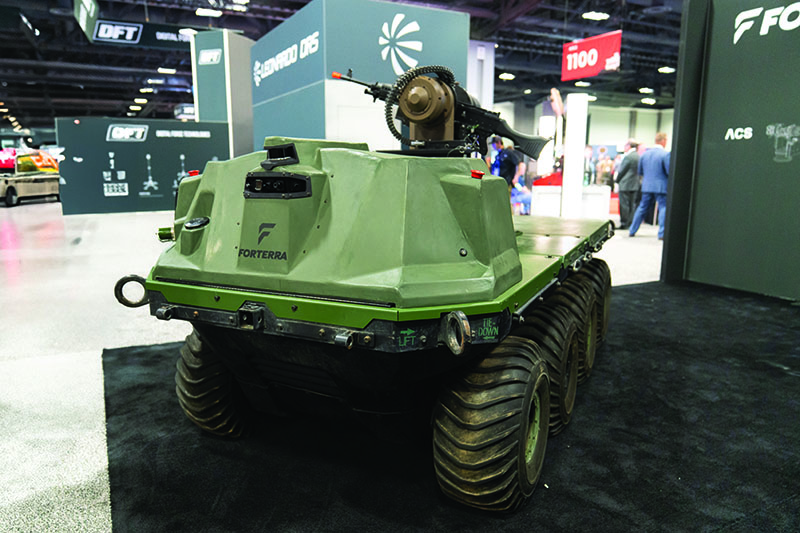
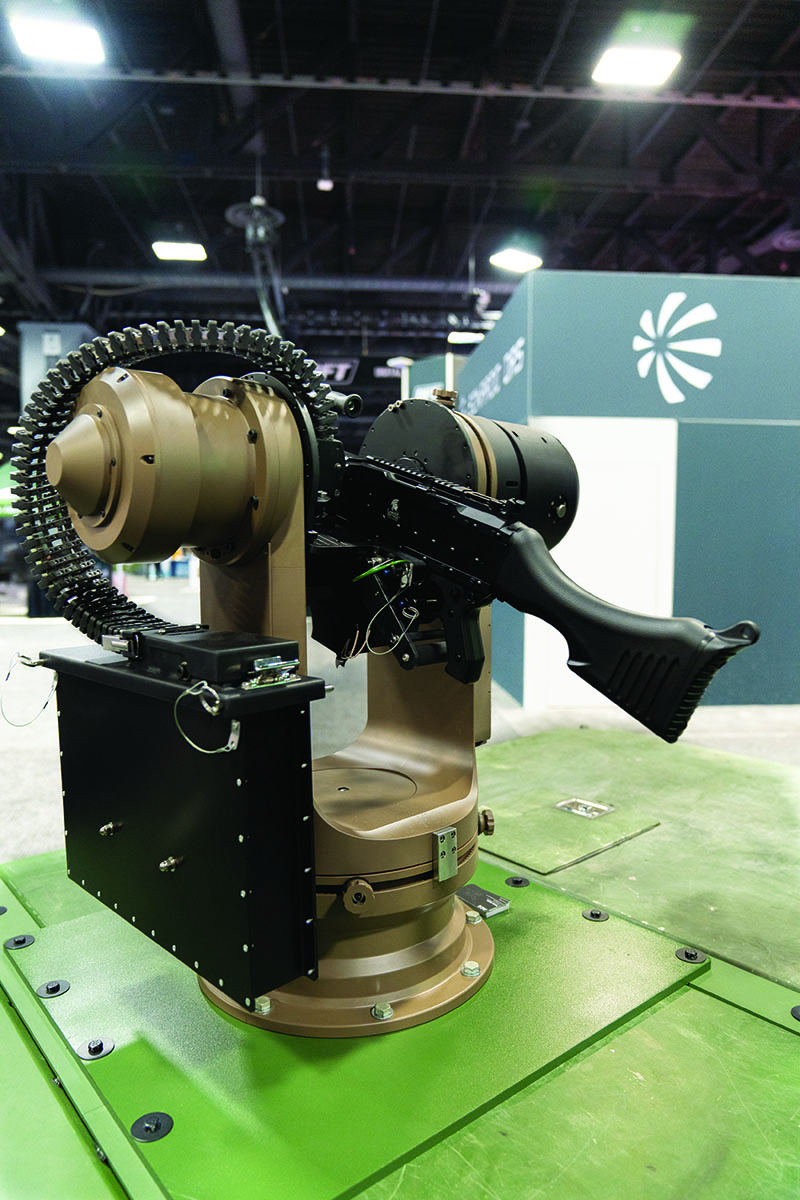
For UGVs operating at the squad level, this level of autonomy is crucial. An AutoDrive-equipped vehicle can trans-port extra supplies and ammunition, evacuate wounded Marines, patrol a perimeter or provide fire support to a squad in contact with the enemy, allowing Marines to focus on the mission instead of a controller. With autonomous vehicles providing organic logistical and fire support at the squad level without the need for additional vehicle crews, an infantry unit can bring more supplies and heavier weapons into battle.
To enable autonomous UGVs to fight alongside Marines in the field, Forterra is working with Allen Control Systems to provide remote weapons stations. The latter company’s Bullfrog system is essentially a small robotic turret designed to operate an unmodified M240B machine gun. Bullfrog uses an infrared camera, artificial intelligence-based targeting software and an onboard ballistic calculator to autonomously identify targets, aim the weapon and adjust its fire. The system is accurate enough to ensure a first-round hit on a standing man-sized target at up to 800 meters, with its range limited only by weather conditions and the inherent precision of the weapon and ammunition. With its superior reaction time over a human gunner combined with a traverse rate of 400 degrees per second and the ability to fire directly overhead, the Bullfrog is ideal for engaging small, fast-moving enemy UAS. Its software currently requires authorization from a human supervisor before it pulls the trigger, but a human operator is not technically necessary for the system to function.
AutoDrive and Bullfrog can interface with existing command, control and communications (C3) networks to share information about the battlespace with friendly units. Even onboard the same vehicle, a Bullfrog turret can instruct the AutoDrive “brain” to search for new targets, for example.
Forterra has demonstrated AutoDrive units on a wide variety of vehicles, ranging from small UGVs to joint light tactical vehicles (JLTVs) and even High Mobility Artillery Rocket Systems. The company is also pushing for wider adoption on commercial vehicles, such as forklifts and trucks, to remove human operators and therefore increase safety at industrial sites such as ports.
BAE Systems’ Amphibious Combat Vehicle (ACV)

The centerpiece of the show was BAE Systems’ amphibious combat vehicle (ACV), the Marine Corps’ replacement for its geriatric assault amphibious vehicle (AAV) fleet. Given its crucial role in the Corps’ mission of expeditionary war-fare, the ACV program has had a high pro-file, especially after a series of rollover accidents in 2022 and 2023. To address the resulting concerns, the Marine Corps has updated its training for vehicle crews to emphasize the new vehicle’s different handling characteristics from the legacy AAV.
The ACV’s most obvious external difference from its predecessor is its wheeled motive system. The debate between wheels and tracks has raged fiercely for decades, but generally speaking, wheels offer greater speed, whereas tracks spread a vehicle’s weight more evenly to provide better mobility over soft ground. With its centralized tire in-flation system, though, the ACV can dynamically reduce the air pressure in its own tires for operation on soft beach sand, for example. Unlike the tracked AAV, which becomes effectively immobile if a track separates or becomes dislodged, an ACV can still move under its own power with up to two of its eight wheels damaged. One additional benefit the wheeled motive system offers is increased comfort for the vehicle’s occupants. Far from a mere convenience feature, this reduces fatigue on the crew and passengers, improving their combat effectiveness.
Safety is a major area of emphasis in the ACV’s design. Although the vehicle has a somewhat high center of gravity, this is a by-product of its use of a V-shaped hull, which offers much greater protection from mines and improvised explosive devices than legacy vehicles’ flat-bottomed hulls. In the event of a rollover, individual seats with har-nesses protect the occupants from injury much better than the primitive bench seats found in the AAV. Although the use of individual seats reduces passenger capacity in relative terms, the standard ACV-P variant can still transport a full squad of Marines in safety and relative comfort.
BAE Systems offers the ACV in four variants. The ACV-P is the standard armored personnel carrier configuration, transporting 13 combat-loaded Marines and armed with a .50-caliber machine gun in a remote weapon station. This variant is by far the most numerous, with more than 300 examples already in Marine Corps service. For direct fire support against fortified positions and light armored vehicles, the ACV-30 gives up five seats in the passenger compartment to replace the machine gun with a 30 mm autocannon turret. Thirty units have been delivered so far, with up to 150 more on order. The ACV-R variant is an armored recovery vehicle mounting a crane and winch to tow disabled vehicles and pro-vide mobile maintenance support; so far, three examples have been produced for testing. The ACV-C is a dedicated com-mand platform, further reducing passen-ger capacity to seven and replacing the remote weapon station with a mounted M240 to free up space for C3 equipment. According to BAE, the ACV’s 690-horse-power engine gives all variants equal or superior mobility and range on both land and water as compared to the AAV.
At this year’s Modern Day Marine, BAE Systems showcased the ACV platform’s modularity with a test chassis in a logistics configuration, its passenger compartment and remote weapon system replaced with a cargo area and a crane similar to that on the ACV-R. This variant is not one the Marine Corps has specif-ically requested, but BAE hopes to dem-onstrate its utility in providing logistical support in contested environments. The crane can hoist up to 4,000 pounds, al-lowing it to lift a power pack (engine and transmission) to aid in repair and main-tenance of other ACVs in the field. The payload bay can store 500 cubic feet and up to 1,000 pounds of cargo, such as fuel containers, spare tires and ammunition; its roof can be opened to allow for direct loading and unloading with the crane.
Designed for frontline combat, the ACV-P and ACV-30 feature the so-called Integrated Combat System (ICS), a sophisticated battle computer that provides increased situational awareness and can help aim the remote weapon stations. Using touchscreen interfaces or physical controls, an ACV crew can work together with the ICS to efficiently locate and destroy a threat before it has a chance to shoot back. The ICS’s semi-autonomous nature allows it to track small, fast-moving targets that would otherwise be difficult for a human gunner to hit. With airburst or proximity-fuze munitions, remote weapon stations on ACVs have been demonstrated shooting down small UAS moving at up to 18 miles per hour. Similar systems have already seen combat use in Ukraine, with at least one recorded shootdown of a cruise missile.
XR Training
To support the ACV program, the Ma-rine Corps put out requests for simulation hardware and software to help ACV drivers and gunners build proficiency outside the vehicle. In February 2024, XR Training was awarded a contract to produce their aptly named Driver Train-ing System (DTS), a custom solu-tion developed specifically to meet the Marine Corps’ needs. So far, XR Training has delivered 81 such systems to Marine installations around the world and is presently working with the Corps to introduce the Gunnery Training System, which is very similar in form and function.
Each DTS unit consists of a seat, a set of hand and foot controls mimicking those of a real ACV and an augmented reality headset, all connected to a laptop computer running the simulation software. The use of augmented reality instead of monitors offers superior immersion; unlike with fully physical or fully virtual solutions, the user can see the physical controls he or she is manipulating inside the simulated environment projected by the headset. The controls and seat are connected to a common chassis, which can articulate like an amusement park ride to simulate the feeling of acceleration and travel over uneven terrain.
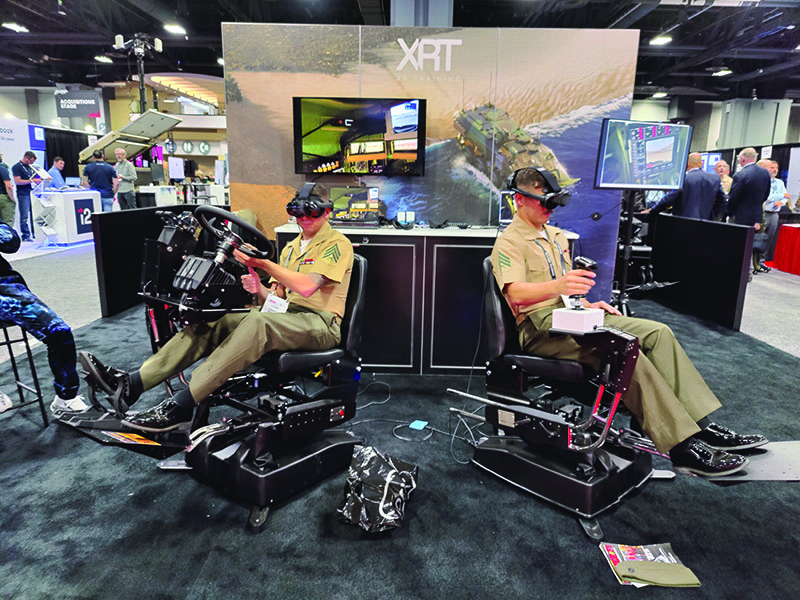
These features combine to create a level of immersion that not only improves the quality of the training, but can even make that training enjoyable. For a generation of Marines raised with video games, the ACV-DTS is essentially a high-tech driving simulator that helps them hone the skills they use every day in 18-series MOS’s. XR Training offered Marines at the expo the chance to trial the system.
After a session on the DTS, MDM attendee Sergeant Chayce Quaranta was quick to point out the value of such realistic simulated training. “I think it’s a good training tool,” he said. “It’s immersive and seems inexpensive.” In his opinion, the system’s video-game-like nature promises to increase its value as a training aid. “With Marines getting excited about that, they’re more likely to learn.”
While Quaranta maneuvered the simulated ACV through a combat zone, Sgt Bryce Jones manned the Gunnery Training System and engaged targets with the vehicle’s remote weapon station. “This does a really good job of showing how hard it is to stay on target in a moving vehicle on rough terrain,” observed Jones, a former crew-served weapons instructor. “Every MOS, I think, should have some level of simulated training.”
Another major area of consideration in the DTS design is modularity. As well as enabling the use of commercial off-the-shelf components to save cost and make maintenance easier, this design paradigm makes the system easy to reconfigure to simulate other types of vehicles should the need arise. Additionally, the entire unit can be fully disassembled in less than half an hour and transported in two Pelican-style cases.
MDM: Hands-On Educational Experience
As in every year, attendees at Modern Day Marine 2025 were treated to the opportunity to see future technology and try it out for themselves. From the Objective 1 Wargaming Convention area to the numerous vehicle and small arms simulators set up for demonstration, Marine visitors were encouraged to participate in the expo. “I expected to get hands-on, but not this hands-on,” said LCpl Michael Walsh after using a JLTV simulator.
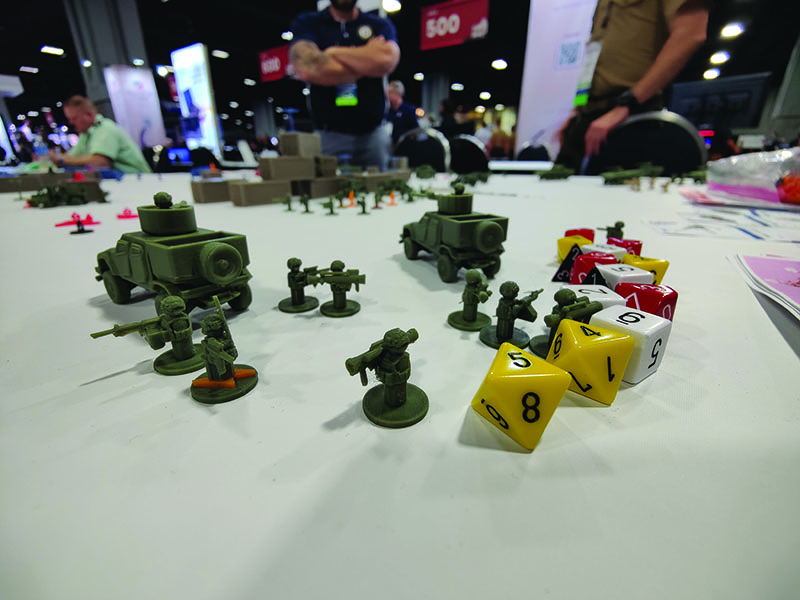
In addition to the acres of high-tech gear, Modern Day Marine hosts numerous professional military education briefings running nearly constantly over its three-day duration. These help place all the fancy gadgets on the show floor into their proper context as essential tools for pres-ent and future warfighters. The expo is a valuable experience “if you’re just looking for a glimpse of how much tech is out there and how the military can actually use it,” according to Master Gunny Sergeant Felipe Lopez, a defense logistics manager at CD&I, “but also you get a glimpse of what the Marine Corps actually provides to the nation—what the Marine Corps is capable of doing and just [how] being equipped with the right gear set makes us that much more lethal.”
Between the near-constant briefings and demonstrations at half a dozen presentation areas and the thousands of corporate, government and nonprofit ex-hibitors, there is always something to see or do at Modern Day Marine, and it only improves with each year. Every Marine attendee interviewed for this article had something positive to say about this year’s expo, but Sgt James Sellers, an air traffic control communications technician, put it the best: “Come to Modern Day Marine!”
Author’s bio: Sam Lichtman is a free-lance writer and editor who specializes in small arms technology and military history. He has a weekly segment on Gun Owners Radio. He is a licensed pilot who lives in Virginia.
Featured Image (Top): Modern Day Marine offers an opportunity to see and learn about new military hardware designed for the battlefields of the future. Built by Pratt Miller Defense, a subsidiary of Oshkosh, this unmanned ground vehicle (above) was just one of the several unmanned systems on display at the expo.


